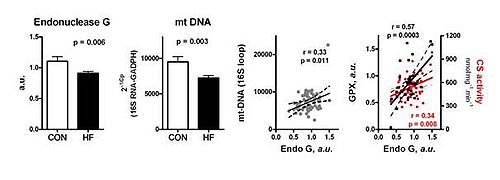Kovalcikova 2015 Abstract MiP2015
| Derangements of myocardial mitochondrial function in patients with end-stage heart failure is associated with reduced endonuclease G. |
Link:
Melenovsky V, Kovalcikova Ja, Mracek T, Benes J, Nuskova H, Drahota Z, Pirk J, Houstek J (2015)
Event: MiP2015
The extent and mechanisms of myocardial mitochondrial dysfunction in patients with heart failure (HF) are poorly understood. Mitochondrial endonuclease G (EndoG) is nuclear-encoded, mitochondria-localised nuclease, experimentally implicated in regulation of apoptosis, mtDNA function, ROS production and cardiac mass, but its relevance to human HF has never been addressed.
Hypothesis: Mitochondrial function is reduced in HF and paralleled by reduction in EndoG activity.
LV free-wall samples were obtained from 62 consecutive patients undergoing heart transplantation (HF group; LV EF 23±9%, age 51±12y, 80% males, HF aetiology: 41% CAD, 59% non-CAD, 31% diabetes) and from 20 HF-free organ donors (CON group; LVEF 55±12%, age 41±15y, 55% males, 12% with diabetes).
Compared to CON, HF patients had reduced mtDNA content (16S RNA/nDNA-GADPH ratio; -24%, p<0.001). HF patients displayed reduced activity of citrate synthase (CS: -26%, p<0.001) and of oxidative phosphorylation enzymes NADH-cytochrome-c oxidoreductase (NCCR: -24%, p<0.01), succinate-cytochrome-c oxidoreductase (SCCR: -40%, p<0.001) and cytocrome-c oxidase (COX: -38%, p<0.001). High-resolution respirometry confirmed a reduction in COX respiration (-21%, p=0.01) and succinate-supported respiration (-25%, p=0.01) in HF. SDS-PAGE western blot showed similar porin (mitochondrial protein abundance), but decreased components of respiratory chain complex I (NDUFA9: -15%), II (SDH70: -17%), III (core2: -20%) and V (F1α: -14%) paralleled by reduction in antioxidant enzymes glutathion-reductase and –peroxidase (GR: -24%, GPX: -20%, all p<0.01). Endonuclease G was downregulated in HF (-17.6%, p=0.01) and correlated with mtDNA (r=0.33, p=0.01, Fig), complex I-III and V abundances (r=0.33-0.42, p<0.01), CS (r=0.34, p=0.008) and strongly with GR and GPX (both r=0.6, p≤0.005, Figure). HF aetiology (ischemic/non-ischemic), presence/absence of diabetes mellitus or age of HF patients had no consistent effect on these alterations.
In the large group of advanced HF patients, we demonstrated systemic reduction of myocardial mtDNA content, lower abundance of mitochondrial respiratory chain components, lower oxidative phosphorylation activity and reduced mitochondrial respiration. Reduced myocardial endonuclease G may contribute to mitochondrial dysfunction in human HF.
• O2k-Network Lab: CZ Prague Houstek J
Labels: MiParea: Respiration, Patients Pathology: Cardiovascular Stress:Ischemia-reperfusion Organism: Human Tissue;cell: Heart
Enzyme: Complex I, Complex II;succinate dehydrogenase, Complex III, Complex V;ATP synthase
Pathway: N
HRR: Oxygraph-2k
Event: A1, Oral
MiP2015
Affiliations
1-Dept Cardiology, Inst Clinical Experimental Med; 2-Dept Bioenergetics, Inst Physiology Czech Acad Sc, Prague, Czech Republic. - [email protected]
Figures
Acknowledgements
Research relating to this abstract was funded by Grant Agency of the Ministry of Health of the Czech Republic (NT14050-3/2013).
